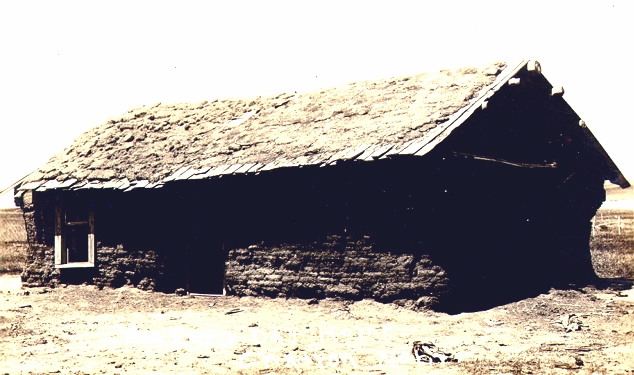
Sod House, near Chadron, Neb., undated
Note sod roof. Although today sod houses are most often associated with Kansas and Nebraska, sod has
been used as a building material throughout history. It was used by Vikings and in northern Europe. Indeed, even today as depicted
below, examples of sod houses may be found in Iceland.
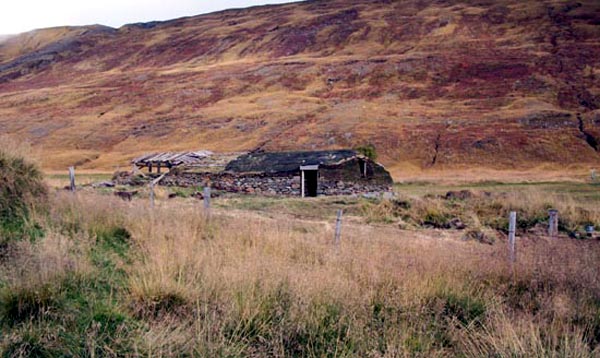
Remains of Sod House, Eastern Iceland, 2012. Photo by Geoff Dobson
The Viking lodge at
LŽAnse aux Meadows, Newfoundland, constructed about 1000 A.D. was a very elaborate soddy bearing remarkable similarity to some
Icelandic soddies constructed in the early Twentieth Century.
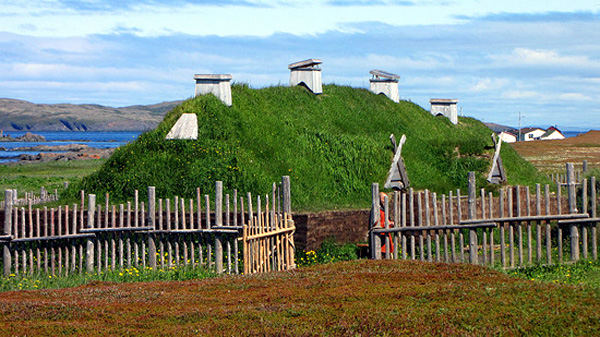
Reconstructed Viking longhouse, LŽAnse aux Meadows, Newfoundland
Sod houses could be found in Russia, Alaska, Labrador. On the Great Plains, without wood or stone, its use of sod was a
matter of necessity. Thus, on the Great Plains from Texas to the Canadian Prairie Provences,
it was used for all manner of structures, houses, schools, barns, and near Moorcroft, Wyoming, a sod gas station.

Sod Gas Station, U.S. 16, between Upon and Moorcroft, Wyoming.
To protect the sod from erosion, it was plastered with a mixture of gumbo, sand and wood ashes.
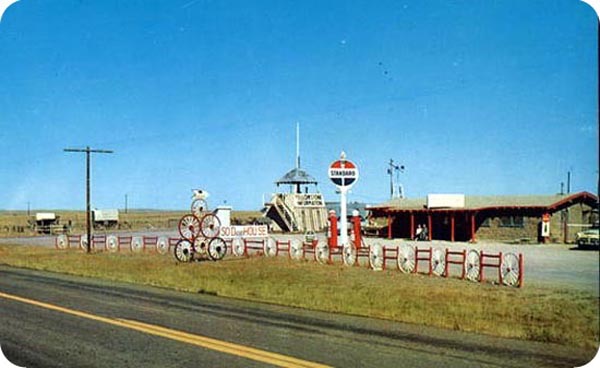
Sod Gas Station, U.S. 16, between Upon and Moorcroft, Wyoming, 1960.
The military constructed sod forts such as
as Fort Mitchell, 55 miles east of Ft. Laramie, built in 1864 to guard the Oregon Trail and
the mail route.
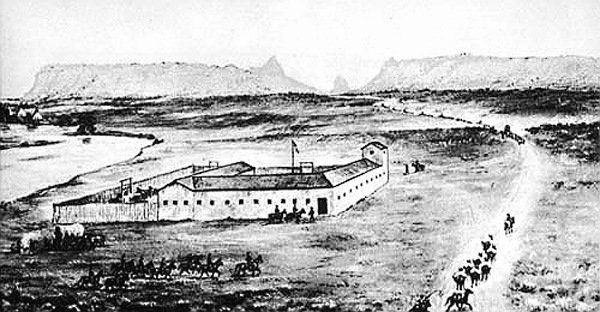
Fort Mitchell, approx. 1868, sketch by Wm. H. Jackson
Following the failure of the Detroit Publishing Company, William Henry Jackson, in the 1930's began a
series of sketches and paintings of the Oregon Trail. The sketches were primarily from memory from the time
when he worked as a bullwhacker on the trail. Many of those sketches are now on display in
the museum at the Scott Bluff National Monument. Following the 1868 Treaty of Ft. Laramie, Ft. Mitchell was abandoned and
all physical trace of it has now disappeared.
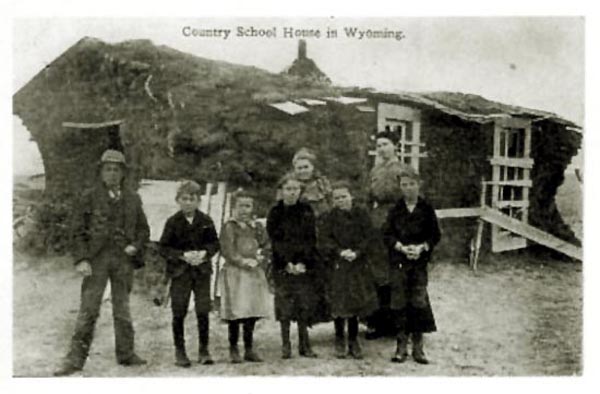
Abandoned Sod Schoolhouse, Wyoming, location unidentified, approx. 1910,
Sod school houses were quite common in the Dakotas, Nebraska, Kansas, and Oklahoma.
Of the 5,937 schoolhouses reported in Nebraska in 1890, 792 were constructed of sod. One county superintendent cpmtemded
that many districts prefered to build a sod school house that may last three or four years rather than having to
issue to bonds. He noted that the two reports of daily attendance in his county were from sod school houses.
Another defended sod school house in that "no other kind of building is more comfortable or safe when the blizzard howls
and the steady cold of winter has settled down." In 1918 there were still
sod school houses in northern and western Nebraka. In 1915 there were still 54 sod school houses in South Dakota and as
late as 1928, Wyoming had 8 adobe or sod school houses.
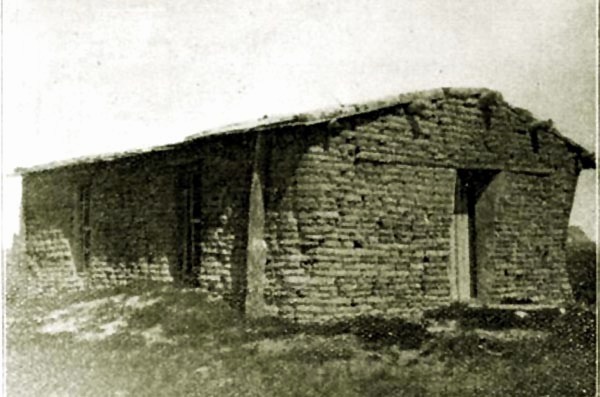
Abandoned Sod Schoolhouse,Gering, Nebraska,
Phebe West, a former teacher in a sod school house i;n; Perkins County, South Dakota, indicated that teaching in a
sod school house may give "rather a poor impression, but it is not a schoolhouse to be ashamed of." Hers had a heating system
fueled by locally mined lignite coat. the advantages, she noted, were "their cheapness in a country
where there is no lumber, their warmth, and the fact that they are not easily wrecked by high wind. The disadvantage is that they
fall to pieces so easily." The Outlook<, August 2, 1922, p. 546.
And if sod schools were common, even more frequent were sod houses constructed by homesteaders and early
ranchers. One writer described the border area of eastern Wyoming and western Nebraska:
"Here in one instance, in a region of bare buttes and sand hills, is a ranch with no other improvements than a low sod house,
a corral, and a windmill, with a rude milk house at its base."
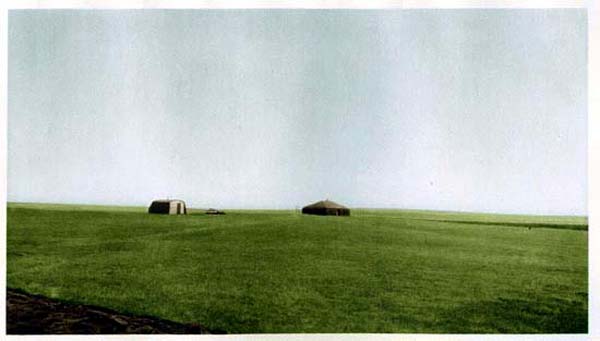
Soddie Homestead on the Plains of Saskatchewan, approx 1926.
Music this page:
Little Old Sod Shanty On My Claim
As performed by Yodeling Slim Clark
I am looking rather seedy now while holding down my claim
And my victuals are not always served the best,
And the mice play shyly 'round me as I nestle down to rest
In my little old sod shanty in the West.
Yet I rather like the novelty of living in this way
Though my bill of fare is always rather tame,
But I'm happy as a clam on the land of Uncle Sam
In my little old sod shanty on my claim.
chorus The hinges are of leather and the windows have no glass
While the board roof lets the howling blizzard in;
And I hear the hungry ki-yote as he slinks up in the grass
'Round my little old sod shanty on my claim.
Oh when I left my eastern home, a bachelor so gay
To try and win my way to wealth and fame,
I little thought that I'd come down to burning twisted hay
In the little old sod shanty on my claim.
My clothes are plastered o'er with dough, I'm looking like a fright
And everything is scattered 'round the room,
But I wouldn't give the freedom that I have out in the West
For the table of the Eastern man's old home.
repeat chorus
And relieve me from the mess that I am in,
The angel, how I'd bless her, if this her home she'd make
In the little old sod shanty on my claim.
And we would make our fortunes on the prairies of the West;
Just as happy as two lovers we'd remain.
We'd forget the trials and troubles we endured at the first
In the little old sod shanty on my claim.
repeat chorus
To cheer our hearts with honest pride of fame,
O then we'd be contented for the toil that we had spent
In the little old sod shanty on our claim.
When time enough had lapsed, and all of those little brats
To noble man- and woman-hood had grown,
It wouldn't seem half so lonely as around us we should look
And see the little old shanty on our claim.
repeat chorus
The above song was published in, among others, the McCook [Nebraska] Weekly
Tribune,November 6, 1884. There is some question as to authorship. The tune has been used in a number of
different songs from the late 19th and early 20th Centuries, including Liitle Joe, the Wrangler, The Titanic, and
The Wreck of the 97.
"Yodeling Slim Clark" (1917-2000) was originally from New England and inspired to become a
cowboy singer after listing to a national broadcast by Montana Slim. He first performed under the name
"Wyoming Buck."
Next Page: Soddies continued.
|